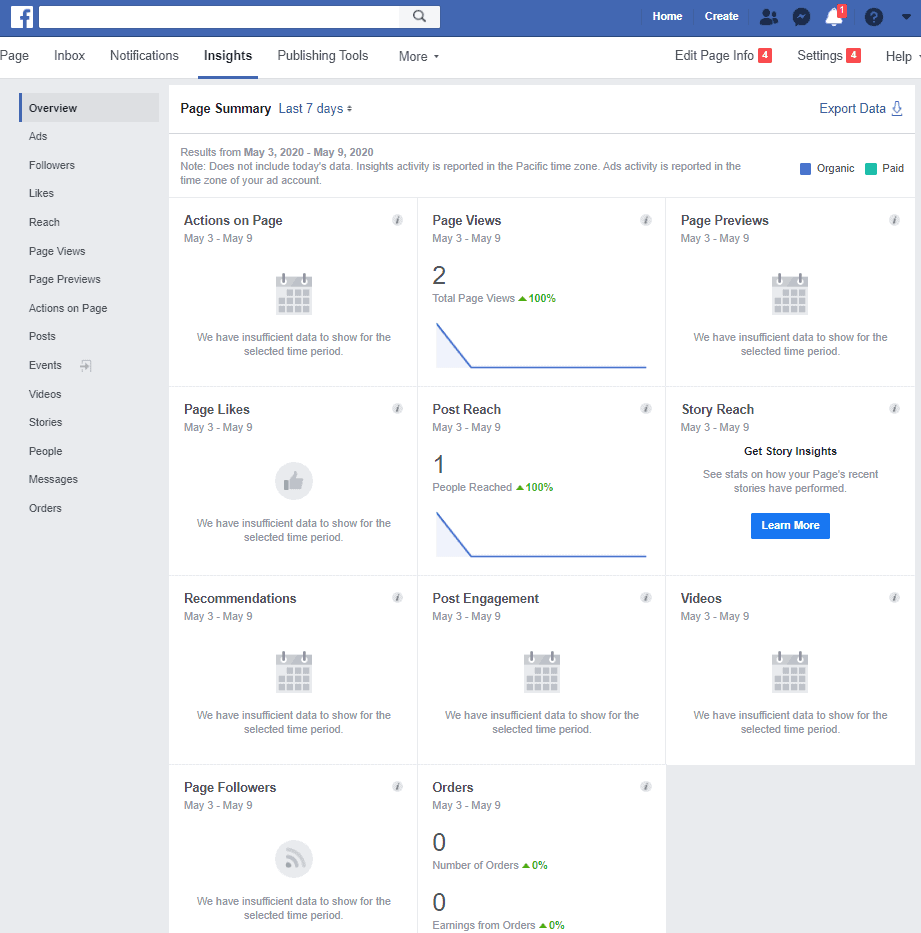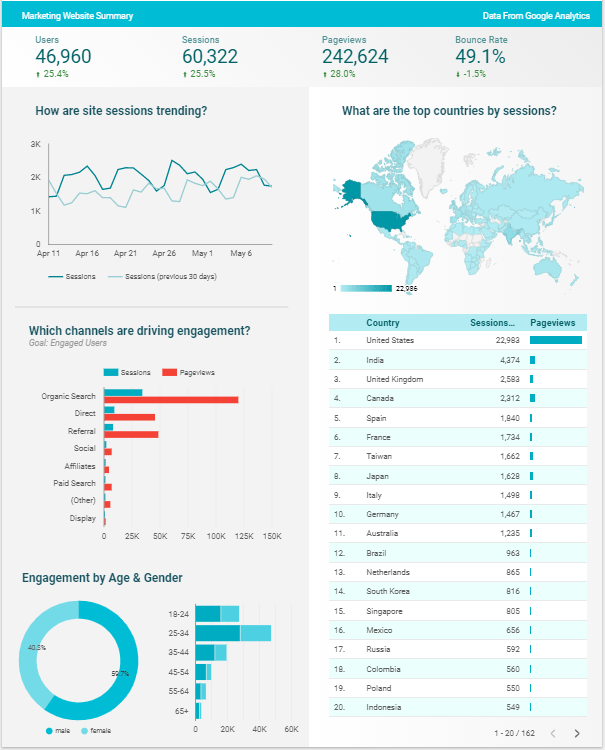We use digital marketing metrics every day to quantify the success of our digital marketing campaigns and those we run for our clients.
In fact, digital marketing metrics are a big part of what makes online marketing so powerful.
With traditional print and billboard ads, it has always been a challenge to measure the true impact of your advertising efforts. How can you ever really know how many people saw a billboard? Or how that billboard impacted their customer journey? You can always estimate, but estimates are inherently subjective and difficult to use as a basis for strategic marketing decisions.
In contrast, user interactions in digital marketing funnels are highly traceable at every stage of the customer journey. Digital marketers can precisely measure how their website, advertisements and landing pages resonate with customers and use that information to better optimize their marketing campaigns.
To unlock the power of digital marketing metrics, marketers need to first know what those metrics are and how they’re used. To make it easy, we’ve created this guide that explains the top 50 digital marketing metrics you should know.
[optin-inline id=’sefz7fnf9gutmokvjsuv’]
Top 50 Digital Marketing Metrics You Should Know
Depending on the types of digital marketing campaigns you work with, you’ll need to use different metrics to measure your success. In this guide, we’ve divided digital marketing metrics by category based on the marketing activities that they describe.
Some of the metrics described here absolutely belong in more than one category.
For example, the “click-through-rate” metric is listed under Digital Advertising Metrics, but it could also be used in B2B marketing, email marketing, and website engagement metrics. Even though the context changes, the basic definition of a click-through rate remains the same. For this reason, we’ve included it just once on our list.
There are thousands of additional marketing metrics you could use to describe your campaigns, but we’ve chosen the 50 most important ones that we think are useful for measuring campaign performance.
Here they are!
Digital Advertising Metrics
Metrics in this category are used to describe a digital advertising sales funnel. Here, the goal is to present the audience with an advertisement, have them click through to a landing page and convert them on either a sales or another type of offer.
- Impressions – The Impressions metric describes the number of times that your ad was displayed to a user on your chosen ad network.
- Clicks – Clicks refers to the total number of clicks that your ad received.
- Advertising Click-Through-Rate (CTR) – Advertising CTR is a metric that describes how often your ad impressions turn into clicks. You can calculate CTR by dividing Clicks by Impressions.
- Conversions – Every digital advertising campaign has a goal, a final step that marketers want their prospects to take. It could be purchasing a product/service, opting into a newsletter, signing up for a free trial, or something else. Every time someone completes a desired action that and satisfies the campaign goal, that’s called a conversion. The Conversions metric describes the total number of times that the campaign goal was satisfied.
- Conversion Rate – Your conversion rate is the total number of conversions divided by the total number of people who viewed your landing page.
- Ad Spend – The total amount of money that you have spent on advertising over a given period.
- Cost Per Conversion – Once you have some conversions for your digital advertising campaign, you can calculate a Cost Per Conversion. Your Cost Per Conversion is the total number of conversions divided by the total dollar amount you’ve spent on advertising.
- Revenue – Revenue is the total of all income generated through your digital ad campaign in a given period. If your landing page sells a product or service, you’ll get some revenue with every conversion. If your campaign goal is to collect email opt-ins, you’ll need additional steps in your sales funnel to convert those leads into revenue.
- Return on Ad Spend (ROAS) – Once your ad campaign generates revenue, you can calculate your Return on Ad Spend (ROAS). ROAS is your total revenue divided by your total ad spending over a given period.

Image: Some of the most important digital advertising metrics are easily accessed from your Google Ads Overview.
B2B Digital Marketing Metrics
B2B sales funnels are complex, take longer to execute than B2C advertising campaigns and should typically involve close collaboration between marketing and sales teams.
B2B leads need to be effectively engaged by marketing teams who understand their needs and carefully qualified according to an established lead scoring system. As leads are developed from brand awareness to product interest and consideration, they can be handed off to members of the sales team for next steps, including product demos, proposals and eventually finalizing a sale.
The metrics in this section are used to monitor the progress of leads in B2B sales funnels and to evaluate the impact of marketing strategies on campaign profitability.
- Marketing Qualified Leads (MQL) – An MQL is a lead that has been qualified by marketing based on predetermined criteria and is ready to be handed off to sales staff for next steps. Marketing and sales teams should develop and agree on criteria for defining an MQL. This will ensure that the right leads are passed to sales at the right time to maximize the chance of converting that lead to a sale. Lead scoring usually depends on two broad factors: lead profile (company, industry, job role, budget) and visitor engagement (interaction with ads, lead forms, emails, website and other touchpoints).
- Sales Accepted Leads (SAL) – An SAL is an MQL that the sales team has agreed meets the acceptable criteria for additional follow-up. Formalizing this stage of the sales funnel helps ensure that marketing teams are held accountable for the quality of leads that are passed on to sales.
- Sales Qualified Leads (SQL) – When sales teams receive an MQL and convert it to an SAL, the next step is to contact the person and assess their real interest level to see if it makes sense to move forward. When an SAL is effectively qualified in this way, the lead becomes a Sales Qualified Lead (SQL).
- Opportunities – When an SQL agrees to take the next step by scheduling a product demo or planning a meeting with additional stakeholders, they become an opportunity. The opportunities metric measures the total number leads that booked a meeting or demo. When a lead becomes an opportunity, the only thing left is to convert them into a sale.
- Lead to Close Ratio (CVR) – Also known as conversion rate, your lead-to-close ratio is your total number of converted opportunities divided by total number of leads. This lets you know how efficiently your team and process are working together to convert leads into customers.
- Cost Per Lead (CPL) – To measure your cost per lead for a B2B marketing campaign, calculate your total marketing spend, then divide that by the total number of leads you’ve generated (They could be MQLs or SQLs – it’s your choice).
- Cost Per Acquisition (CPA) – The CPA metric tells you how much it costs for your B2B marketing campaign to gain a customer. To calculate your CPA, take the total cost of your marketing campaign and divide it by the total number of conversions.
- Average Revenue Per Deal – If each sale or conversion you achieve results in a different amount of revenue, you’ll want to calculate your Average Revenue Per Deal. Take the total amount of revenue that your marketing campaign generated and divide it by the total number of sales or conversions.
- Customer Lifelong Value (CLV) – Businesses generate a significant percentage of their revenue from repeat customers and subscriptions. Customer Lifelong Value is a metric that quantifies the total amount of money a customer will spend with your business throughout the entire customer life cycle.
- Return on Investment (ROI) – ROI measures the overall financial impact of a marketing campaign on your business. To calculate the ROI for your marketing campaign, multiply your Total Customers by Customer Lifelong Value, then divide by the total cost of your marketing campaign.
Social Engagement Metrics
Social engagement metrics are used to quantify how much engagement your brand generates through social channels like Facebook, Instagram, LinkedIn and Twitter.
- Likes – The simplest form of social interaction is a “like” or “reaction”. A “like” means that someone saw your content and took the time to tell you how it made them feel.
- Comments – Tracking the total number of comments on your social channels is a great way to measure how much buzz you’re creating through your content creation efforts.
- Shares – Social shares amplify the reach of your content. By measuring which content types generate the most shares, digital marketers can create strategies to develop content that is more likely to be shared by readers.
- Followers – Followers are fans of your brand who want to receive regular messages and updates from you. Growing your follower numbers on social platforms is an important indication that your social media marketing efforts are having an impact.

Image: Running a Facebook page for your business? Use the Insights tab to help you track social media metrics including views, likes, engagements and total reach.
Email Marketing Metrics
If you’re running e-mail marketing campaigns, you’ll use these metrics to assess how your landing pages and emails are performing and where you can improve them to maximize conversions.
- Open Rate – A metric used to measure the number of subscribers who opened one of your emails.
- Response Rate – A metric that measures how frequently someone responds to one of your marketing emails with the desired action.
- Unsubscribe Rate – The percentage of people who clicked the unsubscribe link after opening one of your emails.
- Bounce Rate – The percentage of emails in a marketing campaign that were not successfully delivered to the subscriber’s inbox.
Website UX & Engagement Metrics
With tools like Google Analytics and Hotjar, digital marketers can measure how users interact with their websites and take steps to optimize user experience and drive conversions. Here are some of the most commonly tracked metrics associated with website UX and engagement.
- Bounce Rate – Bounce rate is a metric that measures how frequently a user lands on your page and leaves without engaging or interacting. Note that this is a different meaning for bounce rate from the one listed under email marketing.
- Average Session Duration– Average Session Duration tracks how long the average visitor remains on your website before going elsewhere.
- Time on Page – While average session time applies to your entire website, the time on page metric measures how long users spend on a specific page before navigating away.
- Pages/Session – This metric tracks the average number of pages viewed across all user sessions on your website.
- Exit Rate – The exit rate metric measures how frequently users leave your website after landing on a specific page. This is especially useful if your website contains a multi-page sales funnel and you need to determine which page or pages are causing prospects to abandon the purchasing process.
- Scroll Depth – Scroll depth is a Google Analytics plugin that measures user engagement by looking at how far users scroll down a given page of your website.
- Website Conversion Rate – The conversion rate for a landing page, or your website as a whole, can be calculated as the total number of conversions divided by the total amount of unique visitors.
Web Traffic Metrics by Channel
Digital marketers can use Google Analytics to collect heavily segmented web traffic data for their websites. These are just a few of the thousands of options when it comes to segmenting web traffic data into individual metrics.
- Organic Traffic – The amount of website traffic that comes from search engines.
- Direct Traffic – The amount of website traffic that comes from users typing the website directly into the address bar of their browser.
- Referral Traffic – The amount of visitors to your website that arrived from a link on another website.
- Social Traffic – The total amount of web traffic that found your website through social media channels.
- Campaign Traffic – The total amount of web traffic generated for your website from a specific marketing campaign.
- Mobile Traffic – Google Analytics allows digital marketers to segment their website traffic by device, so you can see what percentage of visitors to your website are on desktop or on mobile devices.
- Web Traffic by Location – Segmentation by location means that you can see a breakdown of your website traffic by country of origin.
- Web Traffic by Landing Page – Digital marketers can segment their web traffic by landing page to assess which of their landing pages are generating the most traffic.
- Unique Traffic vs Repeat Traffic – Google Analytics can also segment visitors in a given time period into unique (new) visitors and repeat visitors.

Image: Digital Marketers can connect their Google Analytics data with Google Data Studio to create visualizations of website traffic sources and user experience metrics.
Website Performance Metrics
Website performance is an important aspect of both technical SEO and user experience optimization for digital marketers. A great place to start optimizing your website performance is with Google PageSpeed Insights, a free web-based tool that helps marketers diagnose and correct issues that lead to slow page loading times. All of the metrics in this section are used to measure how your website and web pages behave when a visitor tries to interact with them.
- Page Speed – Page speed is a measurement of the loading time for a specific page of your website.
- Site Speed – Site speed is a measurement of the average loading time across all pages on your website.
- First Contentful Paint (FCP) – With respect to a specific web page, FCP measures how long it takes for the first text or images to appear on a screen.
- First Meaningful Paint (FMP) – With respect to a specific web page, FMP measures how long it takes for the main content of a page to appear for users.
- First CPU Idle – First CPU Idle happens when the main thread of a web page is first quiet enough to handle user input. This is a measurement of how long it takes for a web page to become minimally interactive for users.
- Time to Interactive – This metric measures how long it takes for a specific web page to become fully interactive for users.
- Max Potential First Input Delay – This metric measures the delay between the first time that a user interacts with a page and the first time that the browser can respond to that interaction. A long first input delay may be caused by assets on the page that take a long time to load, which negatively impacts user experience.
Summary
Thanks for checking out our list of the top 50 digital marketing metrics you should know!
We all know that we need to optimize our marketing campaigns to get the best performance, but marketers sometimes forget that the first step towards optimization is measurement. If you can’t measure your performance, how will you know when you’re improving?
We hope this list inspires you to pay closer attention to digital marketing metrics and use them to identify the best campaign optimization opportunities.
-
CEO Garrett Mehrguth
Did you enjoy this article?
Share it with someone!
